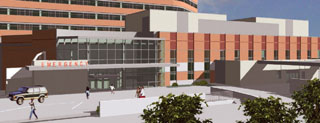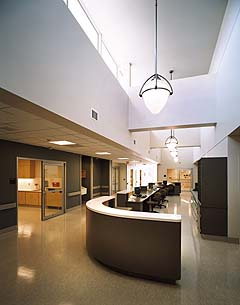
Surveys
DJC.COM
November 18, 2004
A new Rx for emergency room design
Mahlum Architects

Rendering by Mahlum Architects
Evergreen Hospital Medical Center's ER expansion will have a glass entry and lighted "Emergency" sign for high visibility for walk-in patients.
|
Increased patient flows are forcing changes in the design of hospital emergency departments, many of which have been stretched to capacity.
Nationwide, there was an increase of nearly 3 million visits to emergency departments in 2002, according to a report earlier this year by the Centers for Disease Control. In Washington state, emergency department visits increased 11 percent last year, a reflection of population growth and changing health care practices.
As hospitals expand and renovate their emergency departments, they are guided by a number of considerations, including visibility, flexibility, efficiencies, disaster planning, security and patient care.
High visibility
Visibility within the unit allows staff to react without relying on electronic means. When staff can see throughout the department, they can provide immediate assistance.
St. Clare Hospital in Lakewood remodeled its emergency department earlier this year, creating treatment rooms that encircle a central nursing station. The rooms have sliding glass doors to ensure visibility between them and the station, while providing a quieter environment for patients.
Evergreen Hospital Medical Center in Kirkland is undertaking a major expansion of its emergency department that will feature a triangle-shaped nurses' station with visual connection to all the treatment rooms. Visibility will be enhanced by modular furniture systems with no walls above eye level.
Flexibility
Emergency room populations rise and fall by season and time of day, with weekends experiencing the highest traffic. For that reason, it is important that the emergency department and staff be flexible in their ability to treat patients.
At Evergreen, each of the nursing stations and the rooms they serve will be exact duplicates so care delivery can be quickly expanded from one "pod" to a second or third as patient volumes fluctuate. Even scissors, swabs and bandages will be stored in the same location in each room.
Divided into four staff groups, the nurses' stations will be configured to support a modified team structure, rather than teams according to care specialization. Each group will serve all levels of patient care, which will enable the hospital to close down a pod during periods of low patient volume. This generalist approach also will stimulate greater staff interest and skill diversity.
We also encourage hospitals to design in flexibility for future growth, for example, by providing accessibility to wiring systems above ceilings and by considering wireless communications and headsets as a future alternative to over-extended hardwired systems.
Greater efficiencies

Photo by Jim VanGundy
A clerestory channels natural light into the ER nursing station at St. Mary's Hospital in Walla Walla.
|
From the time a patient enters the door, emergency departments are seeking ways to offer quicker, more efficient care. At Evergreen, a patient's needs will be quickly assessed in a triage area. Those with less urgent needs will go immediately to a 10-bed "fast track" unit; those with more critical needs to one of 32 acute care rooms, four of them trauma rooms equipped with high-intensity equipment for resuscitation, intubation and other emergency treatments. An adjacent radiology/CT lab will allow patients to stay within the department for their diagnostic assessments.
The layout of the department, with the nurses' station in the middle, will reduce the amount of walking that staff has to do. Most of the commonly used supplies will be stored and stocked using a cart system built into the central work area to increase availability to staff and to increase efficiency in restocking.
Disaster planning
Since the Sept. 11 attacks, hospitals have increasingly been viewed as disaster control centers and there has been a direct effect on the design of emergency departments.
To deal with biological warfare, bombing and natural disasters, emergency departments will need to balance specialization with flexibility. For example, rooms that can be negatively pressured will better support airborne disease control.
Given the large populations potentially affected by such disasters, decontamination rooms generally will need to be larger than previously designed.
Evergreen's emergency department will have alternative power and water sources independent of the main hospital. Outdoor parking canopies equipped with water taps, data points, electrical outlets and lighting will allow the area to be used for outdoor treatment in the event of a disaster. There will also be a special entrance and isolated rooms for patents with infectious diseases or suffering from a chemical attack.
Security
Security ranks high on the list of issues to be addressed in new and expanding emergency departments. Drive-by shootings, terrorist attacks and other threats compromise the security of hospital staff and patients. Architecturally, these risks translate into the increased use of reinforced exterior walls, bulletproof glass and limited vehicle access at the front door and drop-off zones. Increased surveillance and on-site security guards also assist in providing a safe environment.
Patient care
In planning an emergency department, the goal is to move people efficiently through the system, to diagnose and stabilize them quickly with minimal or no backtracking. Virtually all emergency departments now have two entrances, one for patients brought by ambulances and the other for walk-ins. Increasingly, elderly and uninsured people are using the emergency departments for primary or basic care.
Clear signage and other forms of way-finding are especially important for walk-ins and their families. Ambulance entries should not be visible from walk-in entries and they should be separated from the main entry of the hospital. Interiors should promote calming for both patients and families, with visual and auditory screening between waiting rooms and treatment areas.
Hospitals are increasingly providing amenities to make patients more comfortable, even for short stays. At Evergreen, acute-care rooms will have a television, chairs for family members and staff supplies kept in the same place in every room.
Collaboration
Regardless of the complexity of the project, good design requires close and ongoing collaboration between the architectural team, emergency department staff and hospital administrators.
Mahlum Architects begins the process with a series of charrettes in which we meet with team members to discuss various design alternatives. That process can produce an innovative design, such as the unusual triangle-shaped nursing station concept at Evergreen. The design there was influenced by the experiences of former medical director Dr. Charles Pilcher and a dedicated team of experienced front-line staff.
On another project, close collaboration provided the answer to a hospital's need for a large-scale disaster without significantly overbuilding the department. The solution: Large triage rooms that can be combined to form treatment rooms, generous seating areas in family waiting rooms and extended stretcher holding areas.
Robert Lober, AIA, is a principal with Mahlum Architects. He is director of the firm's Seattle studio that specializes in healthcare and technology.
Other Stories:
- Peering into the future of urban supermarkets
- Preparing the next design pioneers
- A new tool for analyzing seismic hazards
- Don't sacrifice green design to 'value engineering'
- How buildings can help 'reforest' a city
- Opportunities abound in China for A/E firms
- What owners need to know about seismic design
- Unique design brings Boeing workers together
- Ready to go national with your design firm?
- A/E firms look to plastic for growth
- Skinner Building gets a seismic skeleton
- Waterlogged walls? New system will tell you
- Designers — beware of technology convergence
- A past blast: building the road to St. Helens
- Commissioning squeezes the best out of buildings
- Designers have lofty aspirations for housing
Copyright ©2009 Seattle Daily Journal and DJC.COM.
Comments? Questions? Contact us.